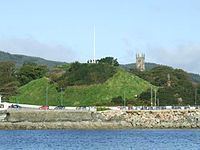Status No longer standing | Address Castle Gardens | |
 | ||
Country Scotland, United Kingdom Coordinates , National grid reference NS 04064 91102 | ||
Dunoon Castle;, is a ruined 12th century castle located at Dunoon on the Cowal peninsula in Argyll and Bute, Scotland. The castle sat upon a cone-shaped hill of about 80 feet high, a volcanic plug. Very little remains of the castle's structure today.
Contents
The remains of the castle and a surrounding area, are a scheduled monument.
The castle was a royal residence in the 14th century, and in the 17th century fell into ruins. The castle originally belonged to the Lamont family but became a royal castle with the Earls of Argyll (Campbells) as hereditary keepers, paying a nominal rent of a single red rose to the sovereign.
14th century
In 1333 Dunoon Castle was besieged and taken by John Baliol, who surrendered it to Edward I of England. An insurrection ensued, driving Baliol out of Scotland. Robert the Steward, later King Robert I of Scotland, arrived in Cowal and, with the help of Colin Campbell of Lochow, retook the castle. Campbell, ancestor of the Argyll Campbells, was made hereditary keeper of the castle and awarded certain lands for his support, providing the family their first footing in Cowal.
16th century
In 1544 Dunoon Castle was besieged by Matthew Stewart, 4th Earl of Lennox. Having eighteen ships and 800 soldiers provided by Henry VIII of England, Lennox succeeded in taking the Castles of Dunoon and Rothesay. Archibald Campbell, 4th Earl of Argyll, was driven out, sustaining great loss.
In 1563, Mary, Queen of Scots stayed at the castle while visiting her half-sister, Jean Stewart, Countess of Argyll, and granted several charters during her visit.
17th century
In 1646 occurred the Dunoon Massacre in which the Campbells slaughtered men, women, children, and infants of Clan Lamont. After the restoration of the episcopacy under Charles II, Dunoon became the residence of the bishops of Argyll for a time. The castle was destroyed during the Earl of Argyll's rebellion against James VII and II in 1685.
20th century
During World War I and II, military fortifications were established at Dunoon Castle for the defense of the River Clyde and the shipbuilding industry.
